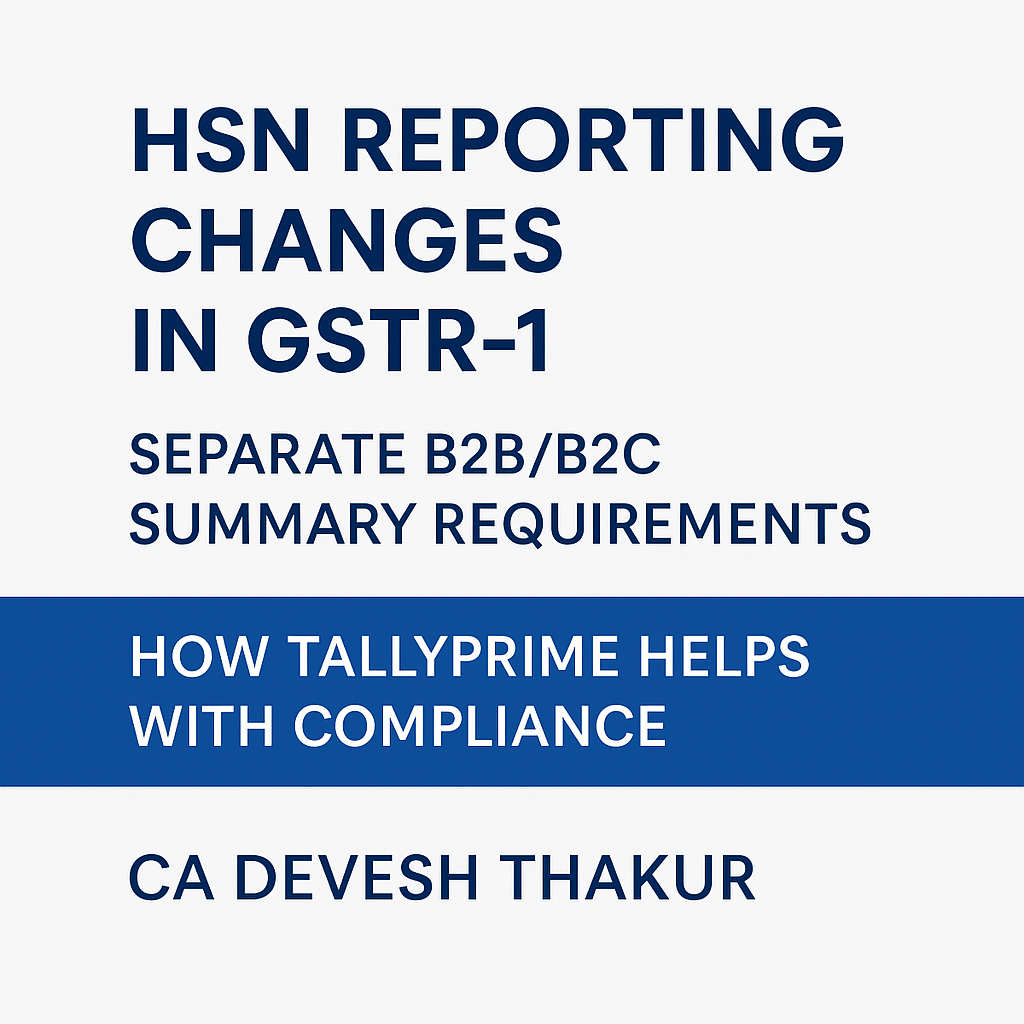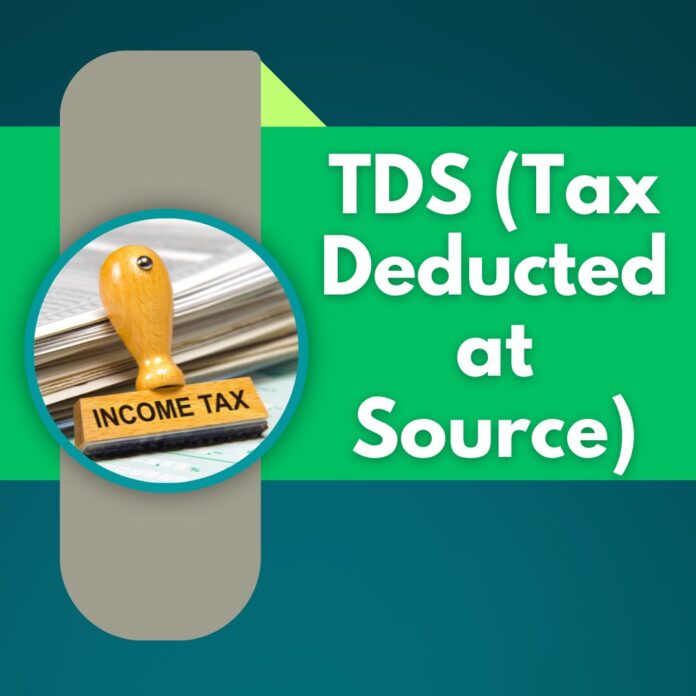GST HSN Summary Reporting Changes
I. Overview of the New HSN Reporting Mandate
The Goods and Services Tax Network (GSTN) is implementing Phase III of enhanced reporting for HSN (Harmonized System of Nomenclature) summaries in GSTR-1. This initiative aims to improve the accuracy and clarity of GST filings by reducing errors and misclassifications.
- Core Change: Businesses will now be required to enter HSN summary details for B2B (Business-to-Business) Supplies and B2C (Business-to-Consumer) Supplies separately in Table 12 of GSTR-1/1A.
- Purpose: The primary goal is to “reducing errors, misclassification and bringing more clarity to GST filings.”
- Impact: “Businesses must adapt their return process to align with the new change of reporting HSN data.”
II. Effective Date of Implementation
The new HSN changes will be effective from the May 2025 tax period onwards.
- Filing Deadline: This means “the GSTR-1 return of May’25 to be filed in June’25, should be filed with separate break-up of B2B and B2C HSN details.”
III. Key Actions for Businesses to Prepare
Businesses must proactively prepare for this change to ensure seamless compliance.
- Adapt Reporting: “Businesses must now prepare to report their HSN summaries with a B2C and B2B breakup.”
- Inform Accounting Teams: It is crucial to “Keep your accounting teams updated on all changes and prepare for the May return filing with a separate list of B2C and B2B supplies.”
IV. Leveraging TallyPrime for Compliance
The source highlights that accounting software can significantly ease the transition and compliance with the new rules.
- Automated Generation: TallyPrime, in its latest release, is “enhanced with the HSN changes as per advisory issued by the GSTN.” By upgrading, businesses can “automatically generate the HSN summary for B2B and B2C supplies in GSTR-1.”
- Benefits of TallyPrime Upgrade: This feature “ensures seamless return filing and compliance with the latest GST changes.”
- Enabling the Feature in TallyPrime:Press F11 for Company Features.
- Enable ‘Set/Alter company GST rate and other details’.
- Press Ctrl + I for ‘More details’ and select ‘Show More’.
- Select ‘Separate B2B and B2C HSN Summary applicable from’.
- Mention the applicable date as 1-4-2025.
- Open GSTR-1 and select ‘Yes’ for GST update.
- Once enabled, “HSN Summary shows the B2B and B2C and you can drill down for more details.” The HSN breakup will reflect automatically upon exporting the report in JSON or uploading it directly from TallyPrime.
V. Conclusion
The new requirement for separate B2B and B2C HSN summary reporting in GSTR-1 is a significant change aimed at improving the quality of GST data. Businesses must acknowledge the May 2025 effective date and take immediate steps to adapt their reporting processes. Utilizing updated accounting software like TallyPrime can streamline compliance and minimize the additional workload associated with these new reporting standards.
Top of Form
What is the new change in GSTR-1 HSN summary reporting?
The new change in GSTR-1 requires businesses to separately report HSN (Harmonized System of Nomenclature) summary details for B2B (Business-to-Business) supplies and B2C (Business-to-Consumer) supplies. This bifurcation will be reflected in Table 12 of GSTR-1/1A.
When will these new HSN reporting requirements come into effect?
Businesses will need to comply with these new HSN changes starting from the May 2025 tax period. This means that the GSTR-1 return for May 2025, which is typically filed in June 2025, must include the separate breakup of B2B and B2C HSN details.
What is the purpose of this HSN reporting enhancement?
This enhancement, part of Phase III of GSTN’s efforts to improve HSN-wise summary reporting, aims to reduce errors, prevent misclassification, and bring more clarity to GST filings. By separating B2B and B2C HSN data, the authorities can gain a clearer picture of supply chains and transactions.
How should businesses prepare for these new reporting changes?
Businesses should immediately begin preparing to report their HSN summaries with the required B2B and B2C breakup. It is crucial to keep accounting teams updated on these changes and ensure they are ready to compile and file the May 2025 return with the separate list of B2C and B2B supplies.
Can accounting software help businesses comply with these new HSN reporting rules?
Yes, accounting software like TallyPrime has been enhanced to support these HSN changes. By upgrading to the latest release, businesses can automatically generate the HSN summary for B2B and B2C supplies in GSTR-1, streamlining the return filing process and ensuring compliance with the latest GST regulations.
What are the steps to enable and generate B2B and B2C HSN summaries in TallyPrime?
To enable this feature in TallyPrime, users need to:
- Press F11 for Company Features.
- Enable ‘Set/Alter company GST rate and other details’.
- Press Ctrl + I for ‘More details’ and select ‘Show More’.
- Select ‘Separate B2B and B2C HSN Summary applicable from’.
- Mention the applicable date as 1-4-2025. After these steps, opening GSTR-1 and selecting ‘Yes’ for GST update will show the B2B and B2C HSN summary, which can then be drilled down for more details or exported.
Will the HSN breakup automatically reflect when exporting or uploading GSTR-1 from TallyPrime?
Yes, once the B2B and B2C HSN summary is enabled and generated in TallyPrime, the HSN breakup will automatically reflect when the report is exported in JSON format or uploaded directly online from TallyPrime.
What are the main benefits for businesses using updated software for these HSN changes?
Using updated software like TallyPrime for these HSN changes offers several benefits, including seamless return filing, improved compliance with the latest GST regulations, reduced manual effort in segregating data, and minimization of errors and misclassifications in GST filings.
Bottom of Form
GST HSN Reporting Changes: A Comprehensive Study Guide
Quiz
- What is the primary goal of the new HSN summary reporting rule in GSTR-1?
- Which specific table in GSTR-1/1A is affected by this new change?
- When will businesses be required to comply with the new HSN changes for tax period reporting?
- What does the “bifurcation” of HSN summary entail for businesses filing GST returns?
- What are the two specific categories into which HSN summary details must now be separated?
- According to the document, what is the intended benefit of these HSN reporting enhancements?
- What action is suggested for accounting teams to prepare for the new HSN changes?
- How does TallyPrime claim to assist businesses with the new HSN reporting requirements?
- What is the first step to enable B2B and B2C HSN summary in TallyPrime?
- After enabling the setting in TallyPrime, how can a business view the HSN summary with the B2B and B2C breakdown?
Quiz Answer Key
- The primary goal is to reduce errors, misclassification, and bring more clarity to GST filings by requiring separate HSN summary details for B2B and B2C supplies.
- Table 12 of GSTR-1/1A is the specific table affected by this new rule, where businesses report HSN details of outward and other relevant supplies.
- Businesses will have to comply with the new HSN changes from the May 2025 tax period onwards, meaning the GSTR-1 return for May 2025 (to be filed in June 2025) must reflect these changes.
- The bifurcation means businesses need to enter HSN summary details for B2B Supplies and B2C Supplies separately under respective tabs within Table 12 of GSTR-1/1A.
- The two specific categories are “B2B Supplies” and “B2C Supplies.”
- The intended benefit is to reduce errors, misclassification, and bring more clarity to GST filings.
- Accounting teams must be kept updated on all changes and prepare for the May return filing with a separate list of B2B and B2C supplies.
- TallyPrime claims to automatically generate the HSN summary for B2B and B2C supplies in GSTR-1 by simply upgrading to its latest release, ensuring seamless return filing and compliance.
- The first step to enable B2B and B2C HSN summary in TallyPrime is to press F11 for Company Features.
- After enabling the setting, users can open the GSTR-1 report and select ‘Yes’ for GST update, and the HSN Summary will then show the B2B and B2C breakdown.
Essay Format Questions
- Discuss the strategic importance of the GSTN’s Phase III enhancements to HSN summary reporting. How do these changes aim to improve the overall GST ecosystem, and what potential challenges might businesses face during adaptation?
- Explain the concept of “bifurcation” in the context of HSN summary reporting for GSTR-1. Provide examples of what types of transactions would fall under B2B vs. B2C supplies and why this distinction is crucial for tax compliance.
- Analyze the role of technology, specifically accounting software like TallyPrime, in facilitating compliance with new tax regulations. How does TallyPrime’s updated features address the challenges posed by the HSN reporting changes, and what are the benefits of using such tools?
- Outline a comprehensive preparedness plan for a business to adapt to the new HSN summary reporting requirements by May 2025. Consider internal processes, team training, and technology adoption.
- Beyond simply complying with regulations, what broader benefits might businesses realize from accurately segregating and reporting B2B and B2C HSN summary data? Consider aspects like data analysis, business strategy, and error reduction.
Glossary of Key Terms
- B2B Supplies: Business-to-Business Supplies. Transactions where goods or services are supplied by one registered business to another registered business.
- B2C Supplies: Business-to-Consumer Supplies. Transactions where goods or services are supplied by a registered business to an unregistered consumer.
- GSTR-1: A monthly or quarterly return that summarizes all outward supplies (sales) of a taxpayer, including details of HSN.
- GSTN (Goods and Services Tax Network): The non-profit, non-government company responsible for providing the IT infrastructure and services to the Central and State Governments, taxpayers, and other stakeholders for the implementation of GST.
- HSN (Harmonized System of Nomenclature): An internationally standardized system of names and numbers for classifying traded products, used in GST for classifying goods and services.
- JSON: JavaScript Object Notation. A lightweight data-interchange format, often used for exporting data from software applications.
- Table 12 (GSTR-1/1A): The specific section within the GSTR-1/1A return where businesses are required to report HSN details of outward and other relevant supplies.
- Tax Period: The specific duration (e.g., a month or quarter) for which a tax return is filed.
- TallyPrime: An accounting software that helps businesses manage their accounts, inventory, and statutory compliance, including GST returns.




